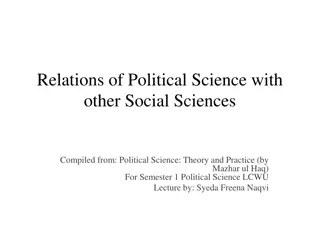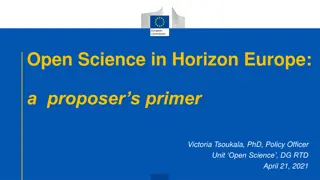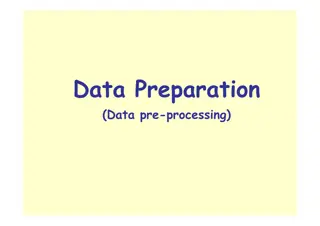Data Preparation in Data Science
Data preparation is a crucial step in the data science process, involving tasks such as data integration, cleaning, normalization, and transformation. Data gathered from various sources may have inconsistencies in attribute names and values, requiring uniformity through integration. Cleaning data addresses errors and ensures quality for downstream analysis, while normalization and transformation optimize data for machine learning algorithms. Dealing with large datasets often involves data reduction techniques to enhance efficiency.
Download Presentation

Please find below an Image/Link to download the presentation.
The content on the website is provided AS IS for your information and personal use only. It may not be sold, licensed, or shared on other websites without obtaining consent from the author.If you encounter any issues during the download, it is possible that the publisher has removed the file from their server.
You are allowed to download the files provided on this website for personal or commercial use, subject to the condition that they are used lawfully. All files are the property of their respective owners.
The content on the website is provided AS IS for your information and personal use only. It may not be sold, licensed, or shared on other websites without obtaining consent from the author.
E N D
Presentation Transcript
Data Preparation Basic Models 1. Overview 2. Data Integration 3. Data Cleaning 4. Data Normalization 5. Data Transformation
Data Preparation Basic Models 1. Overview 2. Data Integration 3. Data Cleaning 4. Data Normalization 5. Data Transformation
Overview Data gathered in data sets can present multiple forms and come from many different sources. Different attribute names or table schemes will produce uneven examples Attribute values may represent the same concept but with different names creating inconsistencies
Overview Integrating data from different databases is usually called data integration. It will produce an uniform data set Data integration it is not the final step. Errors like missing values or uncontrolled noise may be still present.
Overview Data integration is usually followed by a data cleaning step. Even a consistent and (almost) error-free data set may not be adequate for a particular DM algorithm Data normalizations and data transformations may enable or improve the application of DM algorithms to a data set Dealing with large data sets is usually tackled by using data reduction techniques
Data Preparation Basic Models 1. Overview 2. Data Integration 3. Data Cleaning 4. Data Normalization 5. Data Transformation
Data Integration Goal: collect a single data set with information coming from varied and different sources A data map is used to establish how each instance is arranged in a common structure Data from relational databases is flattened: gathered together into one single record
Data Integration Finding Redundant Attributes An attribute is redundant when it can be derived from another attribute or set of them Redundancy is a problem that should be avoided It increments the data size modeling time for DM algorithms increase It also may induce overfitting Redundancies in attributes can be detected using correlation analysis
Data Integration Finding Redundant Attributes 2Correlation Test quantifies the correlation among two nominal attributes contain c and r different values each: where oijis the frequency of (Ai,Bj) and:
Data Integration Finding Redundant Attributes 2works fine for nominal attributes, but for numerical attributes Pearson s product moment coefficient is widely where m is the number of instances, and A ,B are the mean values of attributes A and B. Values of r close to +1 or -1 may indicate a high correlation among A and B.
Data Integration Finding Redundant Attributes Similarly to correlation, covariance is an useful and widely used measure in statistics in order to check how much two variables change together The relation among covariance and correlation is given by: If two variables are independent, the covariance will be 0.
Data Integration Detecting Tuple Duplication and Inconsistency Having duplicate tuples can be a source of inconsistency Sometimes the duplicity is subtle If the information comes from different systems of measurement, some instances could be actually the same, but not identified like that Values can be represented using the metric system and the imperial system in different sources
Data Integration Detecting Tuple Duplication and Inconsistency Analyzing the similarity between nominal attributes is not trivial Several character-based distance measures for nominal values can be found in the literature: The edit distance The affine gap distance Jaro algorithm q-grams WHIRL distance Metaphone ONCA
Data Integration Detecting Tuple Duplication and Inconsistency Trying to detect similarities in numeric data is harder Some authors encode the numbers as strings or use range comparisons na ve approaches Using the distribution of the data or adapting WHIRL cosine similarity metric are better Many authors rely on detecting discrepancies in the data cleaning step
Data Integration Detecting Tuple Duplication and Inconsistency We have introduced measures to detect duplicity in each attribute We can determine whether a couple of instances are duplicated or not using the metrics in several approaches: Probabilistic approaches, as the Fellegi-Sunter model Supervised (and semisupervised) approaches Distance-based techniques Clustering algorithms (for unsupervised data)
Data Preparation Basic Models 1. Overview 2. Data Integration 3. Data Cleaning 4. Data Normalization 5. Data Transformation
Data Cleaning Integrating the data in a data set does not mean that the data is free from errors Broadly, dirty data include missing data, wrong data and non-standard representation of the same data If a high proportion of the data is dirty, applying a DM process will surely result in a unreliable model
Data Cleaning The sources of dirty data include data entry errors, data update errors, data transmission errors and even bugs in the data processing system. Dirty data usually is presented in two forms: missing data (MVs) and wrong (noisy) data.
Data Cleaning The way of handling MVs and noisy data is quite different: The instances containing MVs can be ignored, filled in manually or with a constant or filled in by using estimations over the data For noise, basic statistical and descriptive techniques can be used to identify outliers, or filters can be applied to eliminate noisy instances
Data Preparation Basic Models 1. Overview 2. Data Integration 3. Data Cleaning 4. Data Normalization 5. Data Transformation
Data Normalization Sometimes the attributes selected are raw attributes. They have a meaning in the original domain from where they were obtained They are designed to work with the operational system in which they are being currently used Usually these original attributes are not good enough to obtain accurate predictive models
Data Normalization It is common to perform a series of manipulation steps to transform the original attributes or to generate new attributes They will show better properties that will help the predictive power of the model The new attributes are usually named modeling variables or analytic variables.
Data Normalization Min-Max Normalization The min-max normalization aims to scale all the numerical values v of a numerical attribute A to a specified range denoted by [new minA, new maxA]. The following expression transforms v to the new value v :
Data Normalization Z-score Normalization If minimum or maximum values of attribute A are not known, or the data is noisy, the min- max normalization is infeasible Alternative: normalize the data of attribute A to obtain a new distribution with mean 0 and std. deviation equal to 1
Data Normalization Decimal-scaling Normalization A simple way to reduce the absolute values of a numerical attribute where j is the smallest integer such that new maxA< 1.
Data Preparation Basic Models 1. Overview 2. Data Integration 3. Data Cleaning 4. Data Normalization 5. Data Transformation
Data Transformation It is the process to create new attributes Often called transforming the attributes or the attribute set. Data transformation usually combines the original raw attributes using different mathematical formulas originated in business models or pure mathematical formulas.
Data Transformation It is the process to create new attributes Often called transforming the attributes or the attribute set. Data transformation usually combines the original raw attributes using different mathematical formulas originated in business models or pure mathematical formulas.
Data Transformation Linear Transformations Normalizations may not be enough to adapt the data to improve the generated model. Aggregating the information contained in various attributes might be beneficial If B is an attribute subset of the complete set A, a new attribute Z can be obtained by a linear combination:
Data Transformation Quadratic Transformations In quadratic transformations a new attribute is built as follows where ri,jis a real number. These kinds of transformations have been thoroughly studied and can help to transform data to make it separable.
Data Transformation Non-polynomial Approximations of Transformations Sometimes polynomial transformations are not enough For example, guessing whether a set of triangles are congruent is not possible by simply observing their vertices coordinates Computing the length of their segments will easily solve the problem non-polynomial transformation
Data Transformation Polynomial Approximations of Transformations We have observed that specific transformations may be needed to extract knowledge But help from an expert is not always available When no knowledge is available, a transformation f can be approximated via a polynomial transformation using a brute search with one degree at a time. Using the Weistrass approximation, there is a polynomial function f that takes the value Yifor each instance Xi.
Data Transformation Polynomial Approximations of Transformations There are as many polynomials verifying Y = f (X) as we want As the number of instances in the data set increases, the approximations will be better We can use computer assistance to approximate the intrinsic transformation
Data Transformation Polynomial Approximations of Transformations When the intrinsic transformation is polynomial we need to add the cartesian product of the attributes needed for the polynomial degree approximation. Sometimes the approximation obtained must be rounded to avoid the limitations of the computer digital precision.
Data Transformation Rank Transformations A change in an attribute distribution can result in a change of themodel performance The simplest transformation to accomplish this in numerical attributes is to replace the value of an attribute with its rank The attribute will be transformed into a new attribute containing integer values ranging from 1 to m, being m the number of instances in the data set.
Data Transformation Rank Transformations Next we can transform the ranks to normal scores representing their probabilities in the normal distribution by spreading these values on the gaussian curve using a simple transformation given by: being rithe rank of the observation i and the cumulative normal function Note: this transformation cannot be applied separately to the training and test partitions
Data Transformation Box-Cox Transformations When selecting the optimal transformation for an attribute is that we do not know in advance which transformation will be the best The Box-Cox transformation aims to transform a continuous variable into an almost normal distribution
Data Transformation Box-Cox Transformations This can be achieved by mapping the values using following the set of transformations: All linear, inverse, quadratic and similar transformations are special cases of the Box- Cox transformations.
Data Transformation Box-Cox Transformations Please note that all the values of variable x in the previous slide must be positive. If we have negative values in the attribute we must add a parameter c to offset such negative values: The parameter g is used to scale the resulting values, and it is often considered as the geometric mean of the data
Data Transformation Box-Cox Transformations The value of is iteratively found by testing different values in the range from 3.0 to 3.0 in small steps until the resulting attribute is as close as possible to the normal distribution.
Data Transformation Spreading the Histogram Spreading the histogram is a special case of Box- Cox transformations As Box-Coxtransforms the data to resemble a normal distribution, the histogram is thus spread as shown here
Data Transformation Spreading the Histogram When the user is not interested in converting the distribution to a normal one, but just spreading it, we can use two special cases of Box-Cox transformations 1. Using the logarithm (with an offset if necessary) can be used to spread the right side of the histogram: y = log(x) 2. If we are interested in spreading the left side of the histogram we can simply use the power transformation y = xg
Data Transformation Nominal to Binary Transformation The presence of nominal attributes in the data set can be problematic, specially if the DM algorithm used cannot correctly handle them The first option is to transform the nominal variable to a numeric one Although simple, this approach has two big drawbacks that discourage it: With this transformation we assume an ordering of the attribute values The integer values can be used in operations as numbers, whereas the nominal values cannot
Data Transformation Nominal to Binary Transformation In order to avoid the aforementioned problems, a very typical transformation used for DM methods is to map each nominal attribute to a set of newly generated attributes. If N is the number of different values the nominal attribute has, we will substitute the nominal variable with a new set of binary attributes, each one representing one of the N possible values. For each instance, only one of the N newly created attributes will have a value of 1, while the rest will have the value of 0
Data Transformation Nominal to Binary Transformation This transformation is also referred in the literature as 1-to-N transformation. A problem with this kind of transformation appears when the original nominal attribute has a large cardinality The number of attributes generated will be large as well, resulting in a very sparse data set which will lead to numerical and performance problems.
Data Transformation Transformations via Data Reduction When the data set is very large, performing complex analysis and DM can take a long computing time Data reduction techniques are applied in these domains to reduce the size of the data set while trying to maintain the integrity and the information of the original data set as much as possible Mining on the reduced data set will be much more efficient and it will also resemble the results that would have been obtained using the original data set.
Data Transformation Transformations via Data Reduction The main strategies to perform data reduction are Dimensionality Reduction (DR) techniques They aim to reduce the number of attributes or instances available in the data set Chapter 7 is devoted to attribute DR. Well known attribute reduction techniques are Wavelet transforms or Principal Component Analysis (PCA).
Data Transformation Transformations via Data Reduction Many techniques can be found for reducing the dimensionality in the number of instances, like the use of clustering techniques, parametric methods and so on The reader will find a complete survey of IS techniques in Chapter 8
Data Transformation Transformations via Data Reduction The use of binning and discretization techniques is also useful to reduce the dimensionality and complexity of the data set. They convert numerical attributes into nominal ones, thus drastically reducing the cardinality of the attributes involved Chapter 9 presents a thorough presentation of these discretization techniques
























